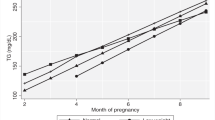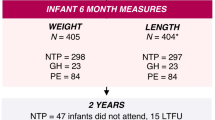Abstract
Objective:
The objective of this study is to estimate associations between changes in maternal arterial pressure during normotensive pregnancies and offspring birth weight and body composition at birth.
Study Design:
Prospective study of 762 pregnant normotensive Colorado women, recruited from outpatient obstetrics clinics. Repeated arterial pressure measurements during pregnancy were averaged within the second and third trimesters, respectively. Multivariable regression models estimated associations between second to third trimester changes in arterial pressure and small-for-gestational-age birth weight, fat mass, fat-free mass and percent body fat.
Results:
A greater second to third trimester increase in maternal arterial pressure was associated with greater odds of small-for-gestational-age birth weight. Greater increases in maternal diastolic blood pressure were associated with reductions in offspring percent body fat (−1.1% in highest vs lowest quartile of increase, 95% confidence interval: −1.9%, −0.3%).
Conclusion:
Mid-to-late pregnancy increases in maternal arterial pressure, which do not meet clinical thresholds for hypertension are associated with neonatal body size and composition.
This is a preview of subscription content, access via your institution
Access options
Subscribe to this journal
Receive 12 print issues and online access
$259.00 per year
only $21.58 per issue
Buy this article
- Purchase on Springer Link
- Instant access to full article PDF
Prices may be subject to local taxes which are calculated during checkout
Similar content being viewed by others
References
Saenger P, Czernichow P, Hughes I, Reiter EO . Small for gestational age: short stature and beyond. Endocr Rev 2007; 28 (2): 219–251.
Villar J, Carroli G, Wojdyla D, Abalos E, Giordano D, Ba'aqeel H et al. Preeclampsia, gestational hypertension and intrauterine growth restriction, related or independent conditions? Am J Obstet Gynecol 2006; 194 (4): 921–931.
McIntire DD, Bloom SL, Casey BM, Leveno KJ . Birth weight in relation to morbidity and mortality among newborn infants. N Engl J Med 1999; 340 (16): 1234–1238.
de Bie HM, Oostrom KJ, Delemarre-van de Waal HA . Brain development, intelligence and cognitive outcome in children born small for gestational age. Horm Res Paediatr 2010; 73 (1): 6–14.
Heinonen K, Räikkönen K, Pesonen AK, Andersson S, Kajantie E, Eriksson JG et al. Behavioural symptoms of attention deficit/hyperactivity disorder in preterm and term children born small and appropriate for gestational age: a longitudinal study. BMC Pediatr 2010; 10: 91.
Haelterman E, Breart G, ParisLlado J, Dramaix M, Tchobroutsky C . Effect of uncomplicated chronic hypertension on the risk of small-for-gestational age birth. Am J Epidemiol 1997; 145 (8): 689–695.
Ananth CV, Peedicayil A, Savitz DA . Effect of hypertensive diseases in pregnancy on birthweight, gestational duration, and small-for-gestational-age births. Epidemiology 1995; 6 (4): 391–395.
Lees CC, Marlow N, van Wassenaer-Leemhuis A, Arabin B, Bilardo CM, Brezinka C et al. 2 year neurodevelopmental and intermediate perinatal outcomes in infants with very preterm fetal growth restriction (TRUFFLE): a randomised trial. Lancet 2015; 385 (9983): 2162–2172.
Steer PJ, Little MP, Kold-Jensen T, Chapple J, Elliott P . Maternal blood pressure in pregnancy, birth weight, and perinatal mortality in first births: prospective study. BMJ 2004; 329 (7478): 1312.
Bakker R, Steegers EA, Hofman A, Jaddoe VW . Blood pressure in different gestational trimesters, fetal growth, and the risk of adverse birth outcomes: the generation R study. Am J Epidemiol 2011; 174 (7): 797–806.
Macdonald-Wallis C, Tilling K, Fraser A, Nelson SM, Lawlor DA . Associations of blood pressure change in pregnancy with fetal growth and gestational age at delivery: findings from a prospective cohort. Hypertension 2014; 64 (1): 36–44.
Macdonald-Wallis C, Silverwood RJ, Fraser A, Nelson SM, Tilling K, Lawlor DA et al. Gestational-age-specific reference ranges for blood pressure in pregnancy: findings from a prospective cohort. J Hypertens 2015; 33 (1): 96–105.
Gluckman PD, Hanson MA, Cooper C, Thornburg KL . Effect of in utero and early-life conditions on adult health and disease. N Engl J Med 2008; 359 (1): 61–73.
Catalano PM, Farrell K, Thomas A, Huston-Presley L, Mencin P, de Mouzon SH et al. Perinatal risk factors for childhood obesity and metabolic dysregulation. Am J Clin Nutr 2009; 90 (5): 1303–1313.
Ellis KJ, Yao M, Shypailo RJ, Urlando A, Wong WW, Heird WC . Body-composition assessment in infancy: air-displacement plethysmography compared with a reference 4-compartment model. Am J Clin Nutr 2007; 85 (1): 90–95.
Oken E, Kleinman KP, Rich-Edwards J, Gillman MW . A nearly continuous measure of birth weight for gestational age using a United States national reference. BMC Pediatr 2003; 3: 6.
Urlando A, Dempster P, Aitkens S . A new air displacement plethysmograph for the measurement of body composition in infants. Pediatr Res 2003; 53 (3): 486–492.
Starling AP, Brinton JT, Glueck DH, Shapiro AL, Harrod CS, Lynch AM et al. Associations of maternal BMI and gestational weight gain with neonatal adiposity in the Healthy Start study. Am J Clin Nutr 2015; 101 (2): 302–309.
Textor J, Hardt J, Knüppel S . DAGitty: a graphical tool for analyzing causal diagrams. Epidemiology 2011; 22 (5): 745.
Tranquilli AL, Giannubilo SR . Blood pressure is elevated in normotensive pregnant women with intrauterine growth restriction. Eur J Obstet Gynecol Reprod Biol 2005; 122 (1): 45–48.
Steegers EA, von Dadelszen P, Duvekot JJ, Pijnenborg R . Pre-eclampsia. Lancet 2010; 376 (9741):631–644.
Carolan-Olah M, Duarte-Gardea M, Lechuga J . A critical review: early life nutrition and prenatal programming for adult disease. J Clin Nurs 2015; 24 (23-24): 3716–3729.
Enzi G, Zanardo V, Caretta F, Inelmen EM, Rubaltelli F . Intrauterine growth and adipose tissue development. Am J Clin Nutr 1981; 34 (9): 1785–1790.
Battaglia FC, Lubchenco LO . A practical classification of newborn infants by weight and gestational age. J Pediatr 1967; 71 (2): 159–163.
Ananth CV, Wen SW . Trends in fetal growth among singleton gestations in the United States and Canada, 1985 through 1998. Semin Perinatol 2002; 26 (4): 260–267.
Jensen GM, Moore LG . The effect of high altitude and other risk factors on birthweight: independent or interactive effects? Am J Public Health 1997; 87 (6): 1003–1007.
Acknowledgements
The Healthy Start study was funded by a grant from the National Institute of Diabetes and Digestive and Kidney Diseases, National Institutes of Health, grant number R01DK076648. APS was funded by a grant from the National Institute of Environmental Health Sciences, National Institutes of Health, grant number K99ES025817. DD, DHG and BMR were funded by a grant from the National Institute of General Medical Sciences, National Institutes of Health, grant number R01GM121081.
Author information
Authors and Affiliations
Corresponding author
Ethics declarations
Competing interests
The authors declare no conflict of interest.
Additional information
Supplementary Information accompanies the paper on the Journal of Perinatology website
Rights and permissions
About this article
Cite this article
Starling, A., Shapiro, A., Sauder, K. et al. Blood pressure during pregnancy, neonatal size and altered body composition: the Healthy Start study. J Perinatol 37, 502–506 (2017). https://doi.org/10.1038/jp.2016.261
Received:
Revised:
Accepted:
Published:
Issue Date:
DOI: https://doi.org/10.1038/jp.2016.261
This article is cited by
-
Body composition in term neonates of mothers with hypertensive disorders of pregnancy
Pediatric Research (2023)
-
Population reference and healthy standard blood pressure range charts in pregnancy: findings from the Born in Bradford cohort study
Scientific Reports (2019)
-
Air displacement plethysmography (pea pod) in full-term and pre-term infants: a comprehensive review of accuracy, reproducibility, and practical challenges
Maternal Health, Neonatology and Perinatology (2018)



